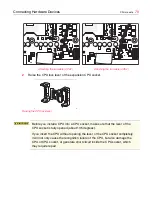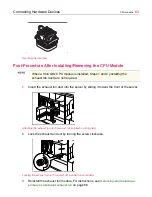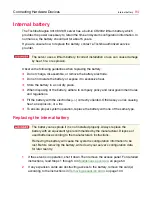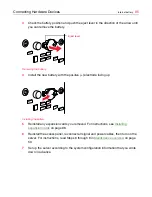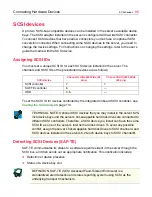
Connecting Hardware Devices
Installing a hard disk drive
93
RAID failures
This section describes how the RAID configuration responds when a component failure
occurs.
Striping configuration failure (RAID 0)
A striping hard disk drive fault represents a critical RAID failure. To recover from a
striping failure, replace the failed drive, then create a new RAID 0 and restore from offline
backup.
Mirrored drive RAID configuration failure (RAID 1)
When a hard disk drive fails in a mirrored array, the sub-mirror that the drive is a part of is
taken off-line. The system routes all data access to the remaining sub-mirror until the
failed drive is either hot-swapped or repaired. The performance of a degraded mirrored
RAID is equal to the performance rendered by the remaining hard disk drive.
Parity RAID configuration failure (RAID 5)
The data in a RAID 5 array is kept in an
encoded format,
distributed across the number of
independent drives in the array. Consequently, write operations on a RAID 5 array are
slower than a non-RAID configuration. This is true even if the parity RAID is functioning
normally. When a hard disk drive in a parity RAID fails, every other hard disk drive in the
array is needed to recover the failed hard disk drives data and to complete the repair
operation.
Because write operations on a RAID 5 array are slow, careful planning should be taken
when configuring a RAID 5 array. For example, if you install the maximum six hard disk
drives in a Toshiba Magnia 3310/3310R server and a drive fails, the read operation from
a failed disk would yield five physical I/O operations.
Installing a hard disk drive
1
If the server is in operation, shut it down, and unplug the power cable(s).
2
Open the upper and lower server doors.
Summary of Contents for Magnia 3310
Page 1: ......

